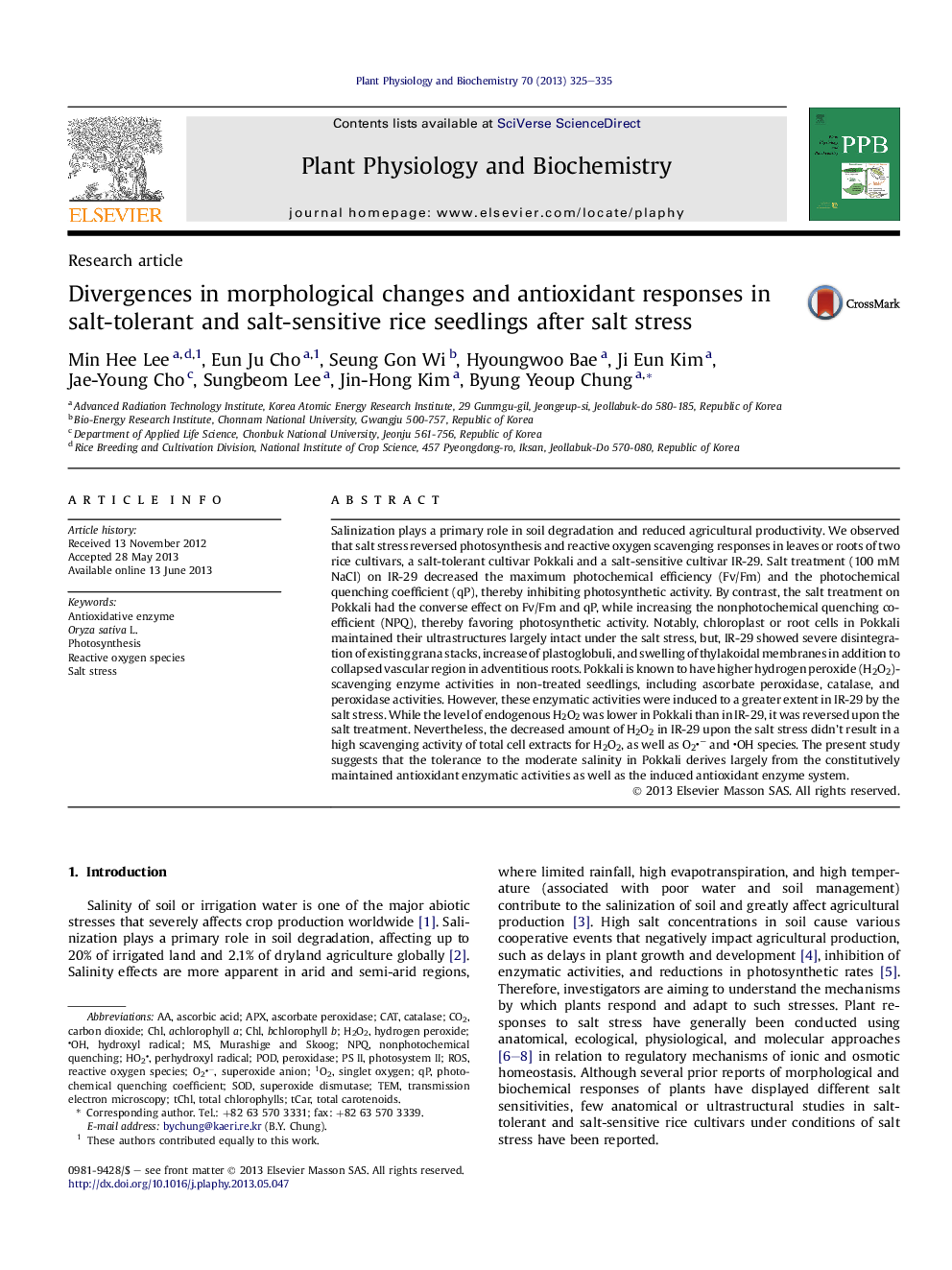| کد مقاله | کد نشریه | سال انتشار | مقاله انگلیسی | نسخه تمام متن |
|---|---|---|---|---|
| 8355659 | 1541951 | 2013 | 11 صفحه PDF | دانلود رایگان |
عنوان انگلیسی مقاله ISI
Divergences in morphological changes and antioxidant responses in salt-tolerant and salt-sensitive rice seedlings after salt stress
ترجمه فارسی عنوان
اختلاف در تغییرات مورفولوژیکی و پاسخ های آنتی اکسیدانی در نهال های برنج مقاوم به شور و نمک پس از تنش شور
دانلود مقاله + سفارش ترجمه
دانلود مقاله ISI انگلیسی
رایگان برای ایرانیان
کلمات کلیدی
NPQTChlChlOryza sativa L.APXCAT1O2PODTCARHO2Murashige and Skoog - Murashige و SkoogO2− - O2-ROS - ROSHydrogen peroxide - آب اکسیژنهAscorbic acid - آسکوربیک اسیدAntioxidative enzyme - آنزیم آنتیاکسیدانیsuperoxide anion - آنیون سوپر اکسیدSinglet oxygen - اکسیژن مجزاTem - این استSalt stress - تنش شوریNonphotochemical quenching - خنثی سازی غیر شیمیاییCarbon dioxide - دیاکسید کربنHydroxyl radical - رادیکال هیدروکسیلSOD - سدSuperoxide dismutase - سوکسوکس دیسموتازphotochemical quenching coefficient - ضریب خنک کننده فتوشیمیاییPhotosynthesis - فتوسنتزPhotosystem II - فتوسیستم 2Transmission electron microscopy - میکروسکوپ الکترونی عبوریH2O2 - هیدروژن پراکسیدPeroxidase - پراکسیدازascorbate peroxidase - پراکسیداز آسکورباتیCatalase - کاتالازCO2 - کربن دیاکسیدTotal carotenoids - کل کاروتنوئیدهاReactive oxygen species - گونههای فعال اکسیژن
موضوعات مرتبط
علوم زیستی و بیوفناوری
علوم کشاورزی و بیولوژیک
دانش گیاه شناسی
چکیده انگلیسی
Salinization plays a primary role in soil degradation and reduced agricultural productivity. We observed that salt stress reversed photosynthesis and reactive oxygen scavenging responses in leaves or roots of two rice cultivars, a salt-tolerant cultivar Pokkali and a salt-sensitive cultivar IR-29. Salt treatment (100Â mM NaCl) on IR-29 decreased the maximum photochemical efficiency (Fv/Fm) and the photochemical quenching coefficient (qP), thereby inhibiting photosynthetic activity. By contrast, the salt treatment on Pokkali had the converse effect on Fv/Fm and qP, while increasing the nonphotochemical quenching coefficient (NPQ), thereby favoring photosynthetic activity. Notably, chloroplast or root cells in Pokkali maintained their ultrastructures largely intact under the salt stress, but, IR-29 showed severe disintegration of existing grana stacks, increase of plastoglobuli, and swelling of thylakoidal membranes in addition to collapsed vascular region in adventitious roots. Pokkali is known to have higher hydrogen peroxide (H2O2)-scavenging enzyme activities in non-treated seedlings, including ascorbate peroxidase, catalase, and peroxidase activities. However, these enzymatic activities were induced to a greater extent in IR-29 by the salt stress. While the level of endogenous H2O2 was lower in Pokkali than in IR-29, it was reversed upon the salt treatment. Nevertheless, the decreased amount of H2O2 in IR-29 upon the salt stress didn't result in a high scavenging activity of total cell extracts for H2O2, as well as O2â and OH species. The present study suggests that the tolerance to the moderate salinity in Pokkali derives largely from the constitutively maintained antioxidant enzymatic activities as well as the induced antioxidant enzyme system.
ناشر
Database: Elsevier - ScienceDirect (ساینس دایرکت)
Journal: Plant Physiology and Biochemistry - Volume 70, September 2013, Pages 325-335
Journal: Plant Physiology and Biochemistry - Volume 70, September 2013, Pages 325-335
نویسندگان
Min Hee Lee, Eun Ju Cho, Seung Gon Wi, Hyoungwoo Bae, Ji Eun Kim, Jae-Young Cho, Sungbeom Lee, Jin-Hong Kim, Byung Yeoup Chung,
